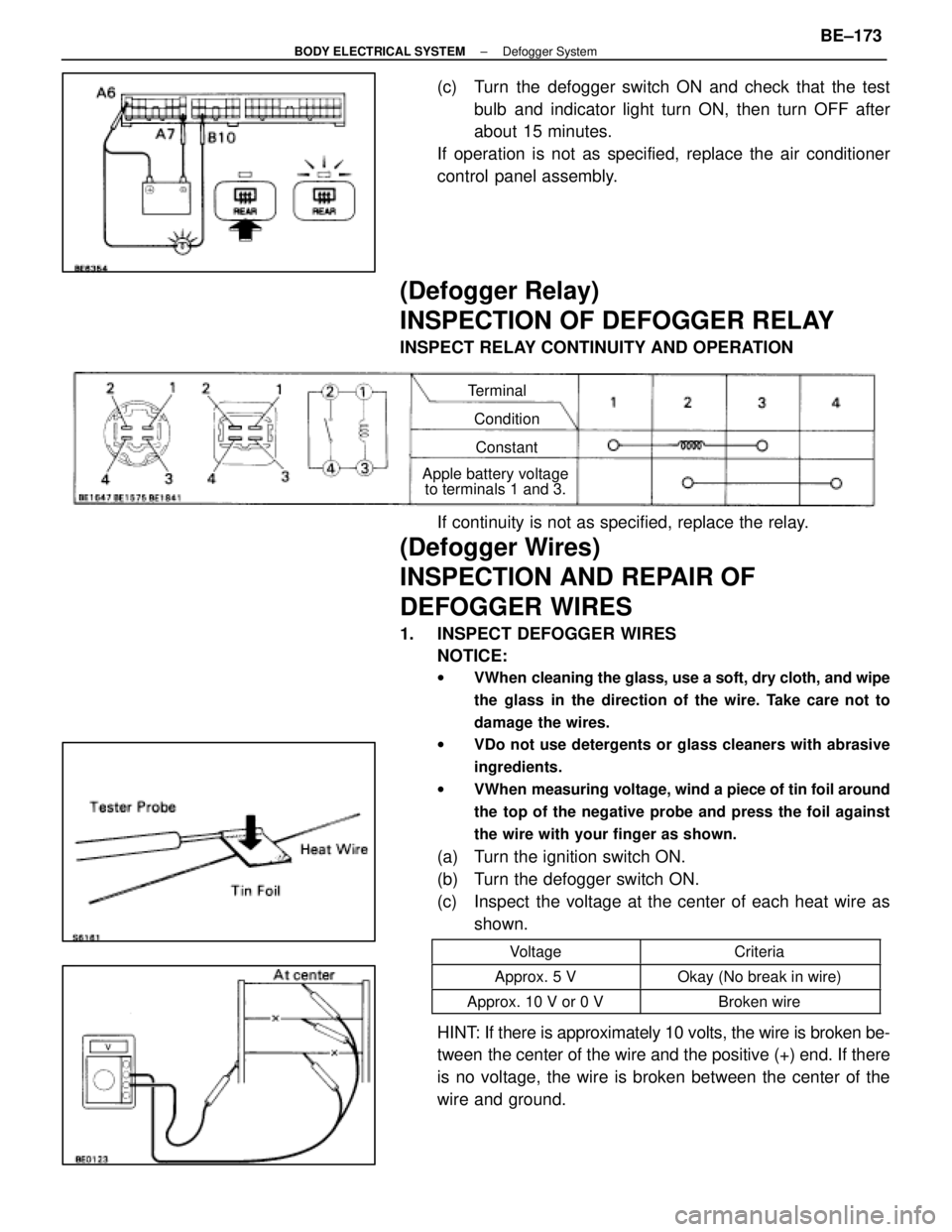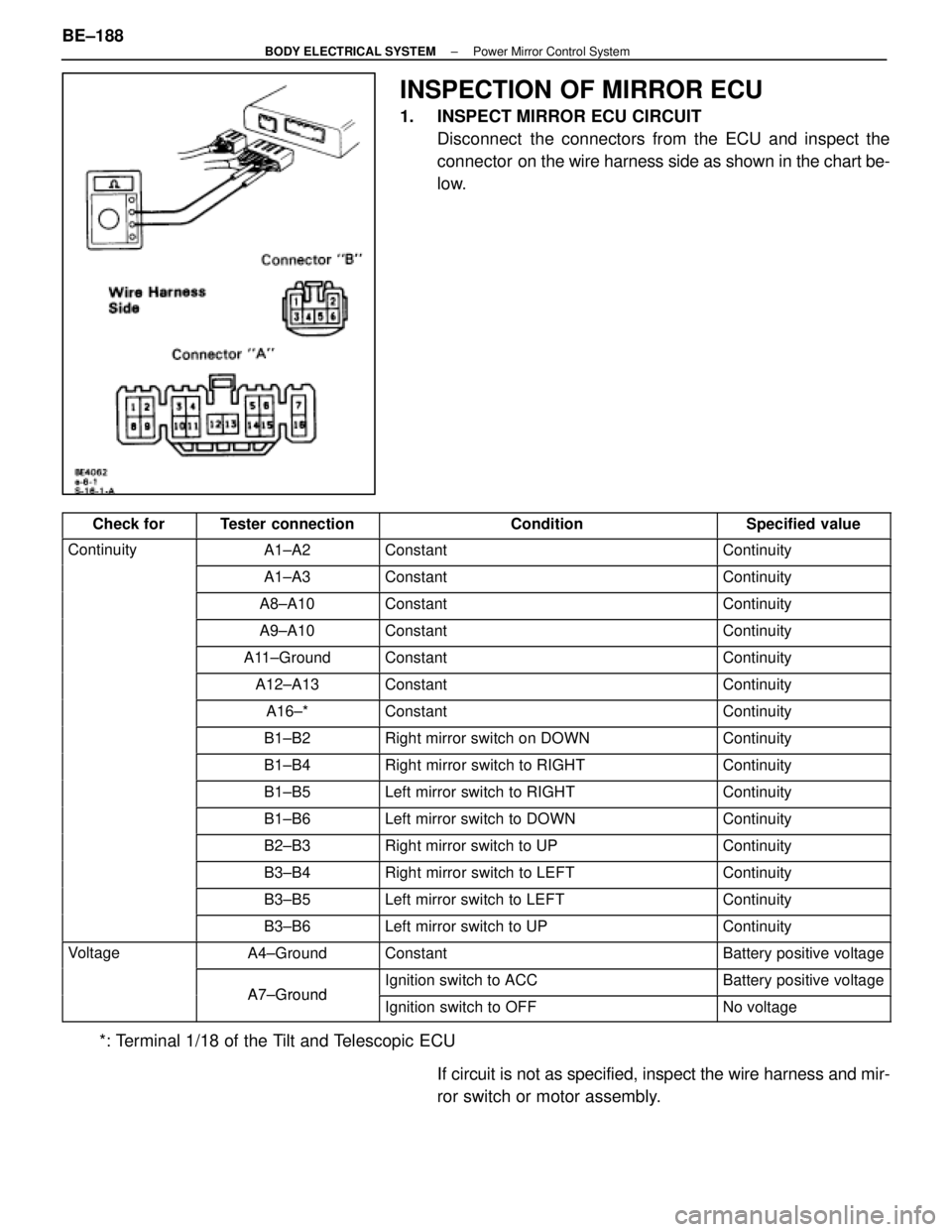Page 557 of 4087
DEFOGGER SYSTEM
Description
The component parts of this system and their functions are described in the\
following table.
Parts NameFunction
DefoggerWhen over current flows in the defogger circuit, the Defogger fuse break\
s the circuit
to protect it against damage.
Defogger RelayThis relay is supplied with current from terminal IG1 of ignition switch\
(Ignition switch ON)
and switches large current from the defogger.
A/C Control Panel
Assembly
� Defogger SwitchThe defogger switch is built into the A/C Control Panel Assembly. This switch is
supplied with current from the relay and fuse HTR. Grounds current from \
the defogger
relay, turning the defogger relay ON.
Defogger
� Rear Window
� Outer MirrorThese defoggers generate heat when current is supplied from the defogger\
relay.
Parts Location
±
BODY ELECTRICAL SYSTEM Defogger SystemBE±171
WhereEverybodyKnowsYourName
Page 559 of 4087

(c) Turn the defogger switch ON and check that the testbulb and indicator light turn ON, then turn OFF after
about 15 minutes.
If operation is not as specified, replace the air conditioner
control panel assembly.
(Defogger Relay)
INSPECTION OF DEFOGGER RELAY
INSPECT RELAY CONTINUITY AND OPERATION
Terminal
ConditionConstant
Apple battery voltage to terminals 1 and 3.
If continuity is not as specified, replace the relay.
(Defogger Wires)
INSPECTION AND REPAIR OF
DEFOGGER WIRES
1. INSPECT DEFOGGER WIRES
NOTICE:
w VWhen cleaning the glass, use a soft, dry cloth, and wipe
the glass in the direction of the wire. Take care not to
damage the wires.
w VDo not use detergents or glass cleaners with abrasive
ingredients.
w VWhen measuring voltage, wind a piece of tin foil around
the top of the negative probe and press the foil against
the wire with your finger as shown.
(a) Turn the ignition switch ON.
(b) Turn the defogger switch ON.
(c) Inspect the voltage at the center of each heat wire as
shown.
VoltageCriteria
Approx. 5 VOkay (No break in wire)
Approx. 10 V or 0 VBroken wire
HINT: If there is approximately 10 volts, the wire is broken be-
tween the center of the wire and the positive (+) end. If there
is no voltage, the wire is broken between the center of the
wire and ground.
±
BODY ELECTRICAL SYSTEM Defogger SystemBE±173
WhereEverybodyKnowsYourName
Page 562 of 4087

SLIDING ROOF SYSTEM
Description
Standby Operation
� Current flows from the DOME fuse to terminal A1 of the sliding roof control rel\
ay (hereafter called
relay).
� When the ignition switch is ON, the current flows from the power window relay to terminal A3 of the
relay.
Operation
Roof Position
Function Fully
Open Fully
Closed
Momentary
Stop
Limit
Switch
No. 1
Limit
Switch
No. 2
Sliding
Roof
Control
Switch Down
Up
Sliding Period Idling Period
CLOSE DOWN OPEN
UP ON
ON OFF
OFF
Tilting
Period
2. OPEN operation
When the switch on the ºOPENº side of the control switch is pushed, co\
ntinuity is produced between termi-
nal A8 of the relay and body ground. Then the relay operates, the curren\
t flows through terminal A3 of the
relay � terminal B3 � terminal 1 of the sliding roof motor � terminal 3 � terminal B1 of the relay � terminal
A5 � the body ground, and the motor starts to run in order to open the slidi\
ng roof.
3. CLOSE operation
When the switch on the ºCLOSEº side of the control switch is pushed, c\
ontinuity is produced between termi-
nal A7 of the relay and body ground. Then the relay operates, the current f\
lows through terminal A3 of the
relay � terminal B1 � terminal 3 of the sliding roof motor � terminal 1 � terminal B3 of the relay � terminal
A5 � the body ground, and the motor starts to run in order to close the slid\
ing roof.
Momentary Stop
When the sliding roof reaches about 200 mm (7.87 in.) short of the fully closed position, the limit \
switch
is turned from ON to OFF, so there is not continuity between terminal B1 of the relay and body g\
round No.
1. As a result, the sliding roof stops at that position.
4. TILT UP operation
When the switch on the ºUPº side of the control switch is pushed, cont\
inuity is produced between terminal
A6 of the relay and body ground. Then the relay operates, the current flow\
s through terminal A3 of the relay
� terminal B1 � terminal 3 of the sliding roof motor � terminal 1 � terminal B3 of the relay � terminal
A5 � the body ground, and the motor starts to run in order to tilt up the sl\
iding roof.
5. TILT DOWN operation When the switch on the ºDOWNº side of the control switch is pushed, co\
ntinuity is produced between termi-
nal A2 of the relay and body ground. Then the relay operates, the current f\
lows through terminal A3 of the
relay � terminal B3 � terminal 1 of the sliding roof motor � terminal 3 � terminal B1 of the relay � terminal
A5 � the body ground, and the motor starts to run in order to tilt down the \
sliding roof.
BE±176
±
BODY ELECTRICAL SYSTEM Sliding Roof System
WhereEverybodyKnowsYourName
Page 563 of 4087
6. TILT UP REMINDER SYSTEMIf the ignition switch is turned from ON to OFF or ACC and the sliding roof rem\
ains tilted up, after 60 seconds
have elapsed or either the driver or passenger door is opened, a buzzer will\
sound for approx. 8 seconds
as a reminder that the sliding roof is tilted up.
Parts Location
±
BODY ELECTRICAL SYSTEM Sliding Roof SystemBE±177
WhereEverybodyKnowsYourName
Page 566 of 4087

(Sliding Roof Control Relay)
REMOVAL AND INSTALLATION OF
SLIDING ROOF CONTROL RELAY
(See Sliding Roof on page BO±85)
INSPECTION OF SLIDING ROOF
CONTROL RELAY
INSPECT CONTROL RELAY CIRCUIT
Disconnect the connector from the relay and inspect the con-
nector on the wire harness side as shown in the chart.
Check forTest connectionConditionSpecified value
ContinuityA2 ± GroundSliding roof control OFF or UPNo continuityyg
switch position (TILT)DOWNContinuity
A6 ± GroundSliding roof control OFF or DOWNNo continuityg
switch position (TILT)UPContinuity
A7 ± GroundSliding roof control OFF or OPENNo continuityg
switch position (SLIDE)CLOSEContinuity
A8 ± GroundSliding roof control OFF or CLOSENo continuityg
switch position (SLIDE)OPENContinuity
B1 ± GroundConstantNo continuity
B1 ± B3ConstantContinuity
B2 ± GroundNo. 1 limit switch
p
osition
OFF (Sliding roof tilt up or
approx. 200 mm (7.87 in.)
opened)No continuity
positionON (Except for conditions
mentioned above)Continuity
B3 ± GroundConstantNo continuity
B4 ± GroundConstantContinuity
B5 ± GroundConstantContinuity
B6 ± GroundNo. 2 limit switch OFF (Sliding roof closed)No continuity
positionON (Sliding roof opened)Continuity
VoltageA1 ± GroundConstantBattery voltageg
A3 ± GroundIgnition switch positionLOCK or ACC ( * )No voltageg
ONBattery voltage
(*) Except within 60 seconds after turning the ignition key to the OFF\
position and both the driver's door and
the passenger's door are closed. If circuit is as specified, replace the relay.
BE±180
±
BODY ELECTRICAL SYSTEM Sliding Roof System
WhereEverybodyKnowsYourName
Page 568 of 4087

Troubleshooting
You will find the cause of trouble more easily by properly using the tabl\
e shown below. In this table, the numbers
indicate the order of priority of the causes of trouble. Check each part in the \
order shown. If necessary, replace
the part.
See page
BE±4,21BE±4,21BE±4,20BE±4,20BE±156BE±152BE±180BE±179BE±179 ±±BE±181BE±26BE±79BE±4,20 ±±
Part
name
Trouble
AM1 FuseDOME FuseDOOR FusePOWER FuseTheft Deterrent and Door Lock Control ECUPower Window Main RelaySliding Roof Control RelaySliding Roof SwitchSliding Roof MotorSliding Rood Motor (Stones to foreign material
trapped in motor assembly)Limit SwitchIgnition SwitchDoor Courtesy SwitchECU±IG FuseWire Harness
*1 Sliding roof system does not operate.1234
*2 Sliding roof system does not operate.35467892110
Sliding roof system operates abnormally.1324
Sliding roof system stops operation half way.1342
Buzzer does not sound.123
Buzzer sounds abnormally.1
ªKey±off Sliding Roofº operation does not
operate.124536
*1: Door Lock does not operate
*2: Door Lock is normal
BE±182
±
BODY ELECTRICAL SYSTEM Sliding Roof System
WhereEverybodyKnowsYourName
Page 574 of 4087

INSPECTION OF MIRROR ECU
1. INSPECT MIRROR ECU CIRCUITDisconnect the connectors from the ECU and inspect the
connector on the wire harness side as shown in the chart be-
low.
Check forTester connectionConditionSpecified value
ContinuityA1±A2ConstantContinuity
A1±A3ConstantContinuity
A8±A10ConstantContinuity
A9±A10ConstantContinuity
A11±GroundConstantContinuity
A12±A13ConstantContinuity
A16±*ConstantContinuity
B1±B2Right mirror switch on DOWNContinuity
B1±B4Right mirror switch to RIGHTContinuity
B1±B5Left mirror switch to RIGHTContinuity
B1±B6Left mirror switch to DOWNContinuity
B2±B3Right mirror switch to UPContinuity
B3±B4Right mirror switch to LEFTContinuity
B3±B5Left mirror switch to LEFTContinuity
B3±B6Left mirror switch to UPContinuity
VoltageA4±GroundConstantBattery positive voltage
A7±GroundIgnition switch to ACCBattery positive voltageA7±GroundIgnition switch to OFFNo voltage
*: Terminal 1/18 of the Tilt and Telescopic ECU
If circuit is not as specified, inspect the wire harness and mir-
ror switch or motor assembly.
BE±188
±
BODY ELECTRICAL SYSTEM Power Mirror Control System
WhereEverybodyKnowsYourName
Page 593 of 4087

(Circuit)
Disconnect the control panel connector and inspect the con-
nector on wire harness side as shown.
Check forTester connectionConditionSpecified value
Voltage2±GroundLight control switch positionTAIL or HEADBattery voltage
OFFNo voltage
If circuit is not as specified, refer to BE±199, 201, 203 wiring
diagrams and inspect the circuits connected to other parts.
(Radio Receiver Assembly)
REMOVAL AND INSTALLATION OF
RADIO RECEIVER ASSEMBLY
(See page BE±112)
INSPECTION OF RADIO RECEIVER
ASSEMBLY
INSPECT RADIO RECEIVER ASSEMBLY
(Circuit)
Disconnect the connectors from the radio receiver assembly.
And inspect the connector on the wire harness side as
shown.
(without CD player)
Check forTester connectionConditionSpecified value
ContinuityA7±GroundConstantContinuity
VoltageA4±GroundConstantBattery voltage
VoltageA3±GroundIgnition switch positionACC or ONBattery voltageg
LOCKNo voltage
A10±GroundLight control switch positionTAIL or HEADBattery voltageg
OFFNo voltage
If circuit is not as specified, refer to BE±199 wiring diagrams
and inspect the circuits connected to other parts.
±
BODY ELECTRICAL SYSTEM Audio SystemBE±207
WhereEverybodyKnowsYourName